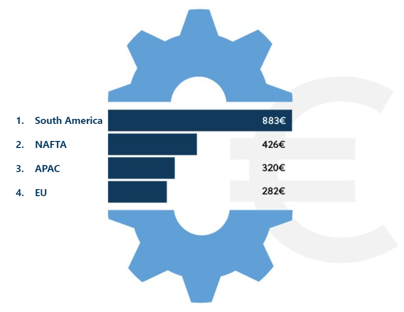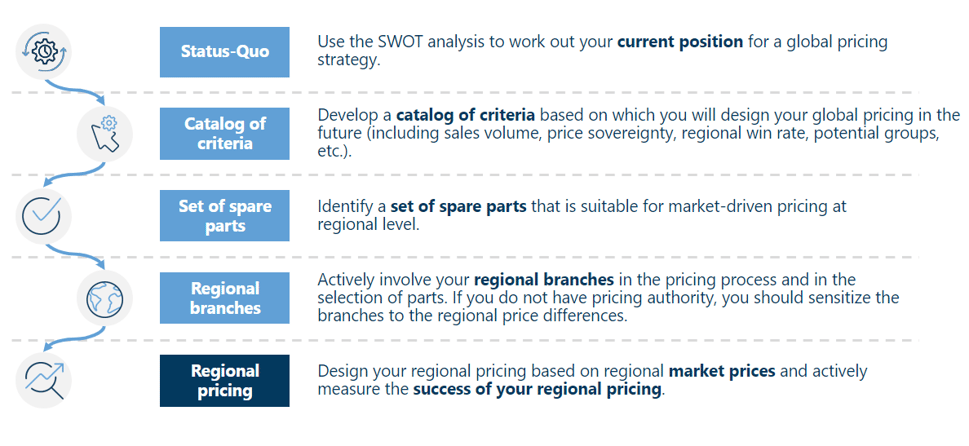Adapting spare part prices to regional markets is still a vastly underutilized tool to enhance revenue potential and customer satisfaction in the crucial after-sales business. In this article, we provide insights into our research data for the first time and explain why developing a regional pricing strategy based on market data is essential for every machinery manufacturer.
Every day in our private lives, we observe regional price differences for the same service. Whether it's refueling, dining out, or online shopping, we notice that prices vary significantly depending on the region where the services are offered. A commonly used example to illustrate geographic price differentials is the Big Mac Index, which is published annually by The Economist magazine.
From the Big Mac Index to the Spare Part Index for regional spare part pricing
The Big Mac Index shows how a highly standardized product – the Big Mac - is offered at different prices in various countries. For example, in 2023, while the Big Mac was the most expensive in Switzerland at $7.26, it was sold for only $1.84 in Egypt, a price difference of nearly 400%. The Big Mac Index aptly highlights the importance of an adapted pricing strategy for each market. This principle also applies to the spare parts business in mechanical engineering.
To illustrate this, we examined a spare part in our research data, which we researched in four different regions in the first quarter of 2024. We then calculated the median price for each region and converted it to euros using the respective exchange rates.

Even this single spare part already illustrates the enormously high importance of geographical price differentiation in spare parts. Despite being the same spare part, the pricing varies significantly, which can be attributed to factors such as regional sales volume, import duties, currency strength, as well as the individual competitive situation and service maturity level of the machinery manufacturer.
Spare part pricing for different regions must always take place at the individual component level
Many machinery manufacturers still employ the traditional markup calculation method to capture regional price differences. In regions like NAFTA, a percentage factor is often added to the entire parts inventory. However, this approach not only results in missed revenue opportunities but also affects customer satisfaction and competitiveness, as shown by MARKT-PILOT market data.
This assertion is aptly supported by our data on spare parts researched in the DACH region and NAFTA in the first quarter of 2024. Each point shown in the following graph represents a price deviation of a spare part. We observe that price fluctuations of over 100% for an identical spare part between these two regions are not uncommon. In 7% of the 2,000 spare parts examined, the price deviation exceeds 150%, as illustrated in our graph.

What specific steps are necessary for developing a regional pricing strategy?
To increase regional revenues in the spare parts business and strengthen the competitive position, we recommend five steps, starting with determining the current company position through the application of SWOT analysis:

How can machinery manufacturers benefit from a regional pricing strategy for their spare parts business?
A regionally oriented pricing strategy offers the following five advantages:
- Regional pricing strengthens customer proximity and allows you to further solidify your role as a reliable partner, positively impacting your image.
- Margin in the spare parts business can be significantly increased through market-oriented pricing.
- By gaining new market knowledge, you enhance your ability to argue for regional pricing.
- Procurement gains negotiation power and can negotiate lower purchase prices for spare parts.
- Harmonizing spare parts pricing creates company-wide transparency and clear processes.
Our research results highlight the importance of adapting regional pricing for spare parts. Developing a global pricing strategy incorporating research findings and pricing recommendations from MARKT-PILOT enables machinery manufacturers to unlock further potential in the spare parts business, contributing to revenue growth and customer satisfaction.
